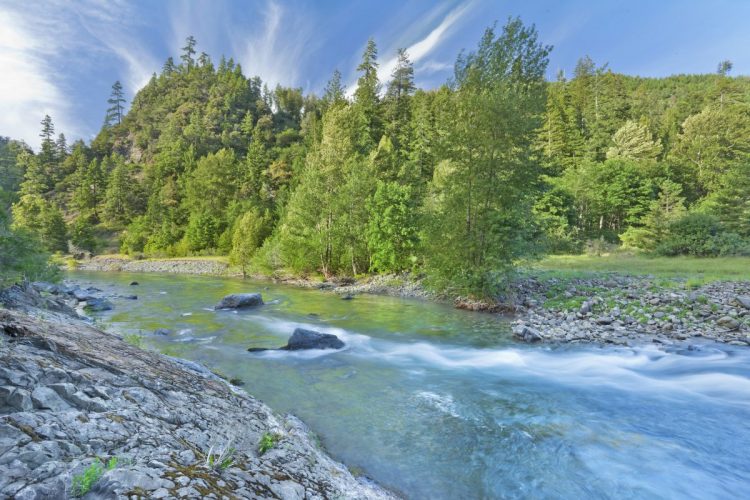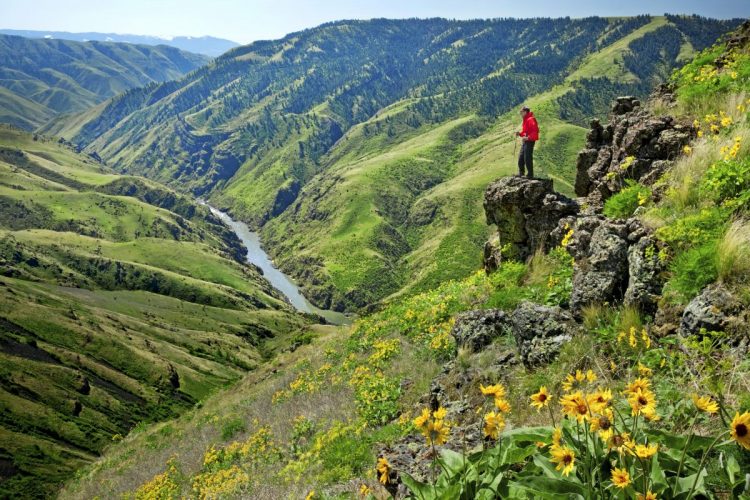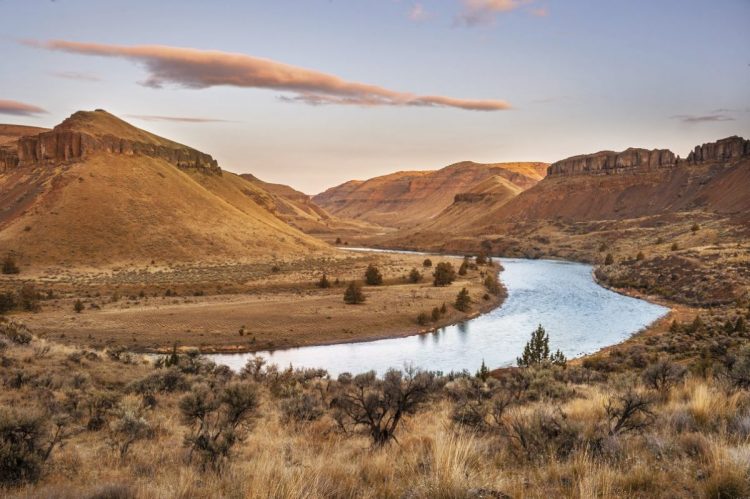Traveling up northern California’s Klamath River to spawn, chinook salmon make a pitstop in an important cold-water tributary, called Blue Creek, to prepare themselves for the long journey east.
“Salmon stop there and lower their body temperature by 8 and a half degrees to allow them to continue their journey upstream to the next cold-water tributary, which is at mile 45 or so,” explains Sue Doroff, president and co-founder of the nonprofit Western Rivers Conservancy (WRC), which is based in Portland, Ore. “Without Blue Creek, the chinook salmon run and the Klamath River system, which is historically the third largest producer of salmon on the West Coast would cease to exist.”
Instead of attempting to protect this important tributary through regulatory or policy means, WRC did what it does best. When a timber company put 47,000 acres of land along 85 miles of Blue Creek up for sale, WRC purchased it. “To do that, we had to raise $60 million, and it was a 10-year project,” says Danny Palmerlee, WRC’s communications director. “It’s one of the most important conservation projects in the Lower 48.”
The project was a partnership with the Yurok tribe, whom WRC transferred the land to and is now its permanent steward — an ideal arrangement, notes Palmerlee.
“You can get out, and you can see and touch and fish and witness exactly what we’ve protected. That sort of undeniable result is what we pride ourselves on and why we think this model is a great one.”
“Blue Creek is a sacred stream to the Yurok people,” he says. “We realized that we have the same conservation vision as the tribe and that they would make the perfect partners.”
Just one of many WRC efforts, the Klamath River project represents the organization’s unique brand of conservation, which is focused on land acquisition. While protecting species and their habitat is the largest driver behind the organization’s work, public access plays a secondary role.
“We buy land along rivers across the West, and we focus on the best rivers, the rivers that have the greatest potential for recovery or great reaches that still need to be conserved,” says Palmerlee. “We then work with a long-term steward and transfer that property; that’s going to be a federal or state agency, sometimes a Native American tribe or a land trust. … The steward that we know can provide the longest, permanent protection is what we’re going for.”
While many organizations exist that are working to address river conservation, Palmerlee believes WRC’s approach is not only unique but also necessary. “We feel like … our brand of river conservation is hugely important because we’re directly and immediately protecting these lands and this habitat along these rivers, and all of our projects have tangible results,” he says. “You can get out, and you can see and touch and fish and witness exactly what we’ve protected. That sort of undeniable result is what we pride ourselves on and why we think this model is a great one.”

A Shared Vision
The decision by Doroff and WRC co-founder Phil Wallin to create the organization more than 30 years ago was in recognition of the threats facing rivers — including an uptick in dam construction — and an acknowledgement that “if fish, wildlife and people are to survive, we need healthy, functioning rivers,” Doroff says. “Rivers are the circulatory system for the environment; without them, nothing will survive. Everything we know and love and need depends on rivers.”
Taking everything she learned in commercial real estate development, she began directing her skills, instead, toward conservation real estate. Now the sole leader of WRC — as Wallin has since retired — Doroff says that, today, one of the most difficult issues surrounding rivers is competing interests.
One aspect of this is water quantity.
“Everybody wants it and there isn’t enough, and so how do you manage it? How do you work with agriculture so they can continue to grow the food that we eat and still leave water in stream for the critters that we need to uphold our ecosystems? So there’s this balance,” says Doroff. “It’s about making management choices.”
Responsible land use and development is also an important part of the equation when it comes to ensuring free-flowing, functioning streams.
“We have to have intact, assembled river corridors, headwater areas and estuaries because it’s like links in a chain,” Doroff says. “You need the links to remain connected and whole to have the ecosystem function.” Yet all of this must be done while continuing to do what we do as humans, she says — living in cities, building houses, growing food.
“An ideal property is one where we know it has tremendous value to wildlife and fish — and one where we’re confident that we can find a long-term steward who’s going to share our vision and be able to take care of it.”
Understanding the need to balance competing interests — “Not every area needs to be protected,” notes Doroff — WRC is strategic in its purchasing decisions, selecting lands where it can have the most impact.
“An ideal property is one where we know it has tremendous value to wildlife and fish — and one where we’re confident that we can find a long-term steward who’s going to share our vision and be able to take care of it,” says Palmerlee.
Sometimes, this means acquiring land that will expand upon an already protected area, helping create migration corridors for wildlife. But overall, Doroff says, “It’s just about being strategic and making sure that what you’re devoting your resources toward will have a real impact that will reverberate throughout the ecosystem.”
One example of how WRC is maximizing its impact is at Ten Mile Creek Ranch, a 2,920-acre property it acquired on the Snake River, downstream of Hells Canyon. While the project will have a positive impact on a variety of species, the main focus is on protecting habitat for a major herd of bighorn sheep that use the property to birth and rear their young.
“Bighorn sheep used to be all up and down the Snake River in Idaho and all over the West, but their numbers have dramatically declined,” Palmerlee says. “One of the most important herds in Idaho is this Hells Canyon herd, and nearly all of the ewes birth and raise their young on this single-ranch property in Idaho on the Snake River. The cliffs and the terrain of the ranch make it ideal. It’s literally the nursery for this herd of bighorns.”

WRC’s biggest and most important project, however, is Klamath River-Blue Creek, according to Doroff. Encompassing nearly 50,000 acres, its influence is felt well beyond its borders. “Its impact is on millions of acres because it is the river that sustains the Klamath-Siskiyou ecoregion, which is one of the planet’s great biodiversity hotspots,” says Doroff. “[Granted,] it’s a single acquisition and a substantial acquisition, but all the same, when you protect 47,000 acres of land in this place, you’re benefiting millions of acres of land that depend on this crucial cold-water stream.”
With offices strategically located across the West — in Portland, Denver, San Francisco and Olympia, Wash. — WRC is poised to act when a prime piece of riparian property becomes available. Often, the organization makes a purchase, after which it works to find the best long-term steward for that property, but sometimes, an acquisition begins as a partnership with a federal land management agency or a tribe that has approached WRC with a conservation real estate opportunity.
Once the process of acquiring land is complete, which can take anywhere from two to upwards of 10 years, the property is handed over to the steward selected by WRC. “Whenever we convey land to a long-term steward, we ensure that it will be managed according to our vision,” says Doroff, “and our vision is conservation.”
When WRC transfers land to a land trust or tribe — the latter of which Doroff refers to as “the original stewards of the land” — an easement is often put in place that outlines a land management plan that captures their shared vision for the landscape. “That is an enforceable document and has oversight from any number of entities,” notes Doroff.
Often, WRC-acquired lands are conveyed to one of the federal land management agencies — the Forest Service, Bureau of Land Management or U.S. Fish and Wildlife Service, for example — and paid for with funds from the Land and Water Conservation Fund. Although this means WRC has less say in the management of that property, Doroff says it provides for permanent protection, bolstered by accountability.

“When we convey to the feds, frequently, it’s in a designated area and has some management prescription overlay that spells out the management vision for that property, and it requires an act of Congress to change,” she says. “While we can’t be sure that every acre of that land will be managed in the way we intended, it is in the public domain, which means the public has a say over how it’s managed.”
WRC’s Impact
The dual benefit of WRC’s effort is that the public often gains access to lands previously off limits. For example, visitors to Cottonwood Canyon State Park in Oregon can now enjoy nearly 16,000 acres on either side of the John Day River that they couldn’t prior to WRC’s acquisition of that land. The area is also an important steelhead spawning territory.
“This is a stretch of the river that was part of the wild scenic river corridor but that was almost totally off limits to the public, so now there’s this great resource there that’s been conserved, and people can get to the river,” says Palmerlee.
In 2018, WRC observed its 30th anniversary, with much certainly worth celebrating. The organization currently has 26 active projects in eight western states and, in its lifetime, has purchased and conserved approximately 175,000 acres along 368 miles of river. As the threats to rivers in the West intensify, so too will the significance of WRC’s work, particularly with regard to climate change.
When thinking about what humans can do in the face of a changing climate, Doroff says, “save rivers.”
“We need to be thinking about what streams are going to be able to be here to sustain these ecosystems in perpetuity. So we favor streams that are cold and spring-fed; we favor streams that have north-facing headwaters,” she explains. “[We] really do have to be strategic in [our] thinking and make sure that we are mitigating as best we can for the effects of a changing climate.”





